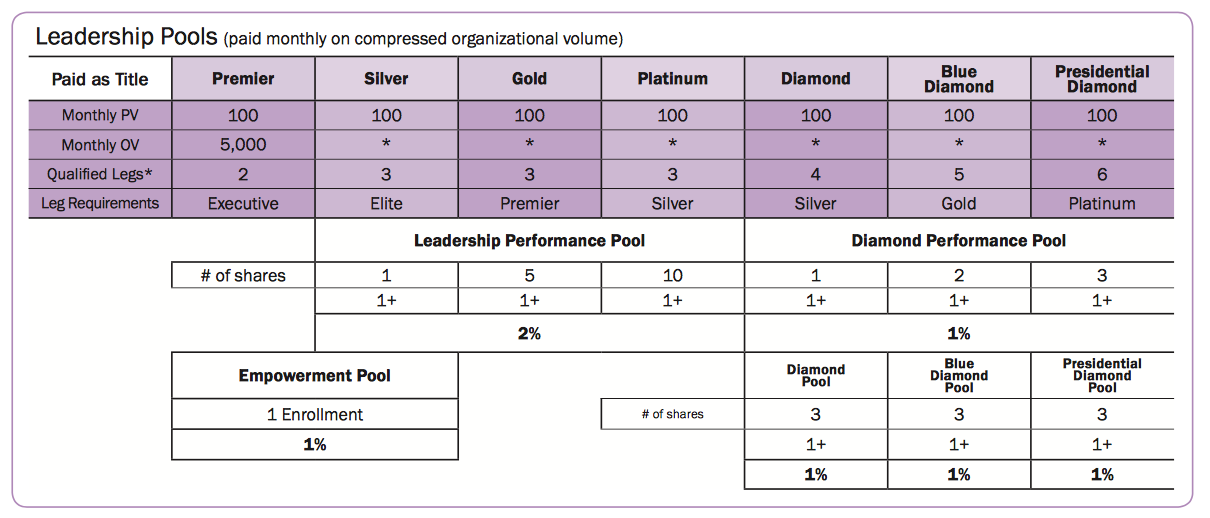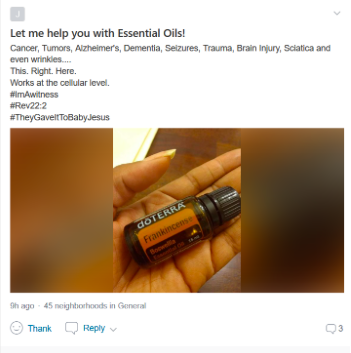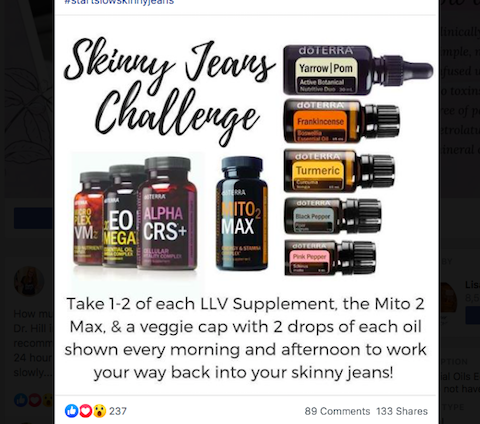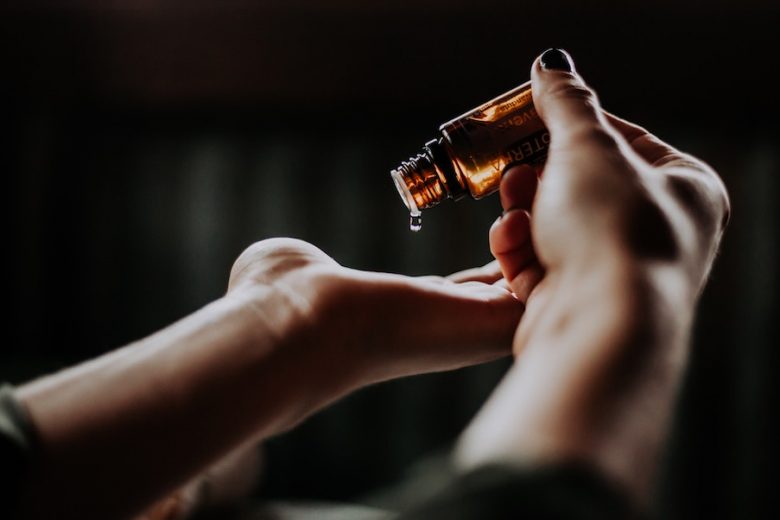How much money can you make with MLM doTERRA?
What’s so special about the MLM doTERRA’s essential oils? And how much money can you make with them? We investigate their income disclosure statement to find out.
Over the past few months, we’ve been seeing more and more about two essential oil MLMs: Young Living and doTERRA. But what’s it really like working for them? And how much money can you earn? To find out, we investigated one of them: doTERRA.
Before we get into actual numbers, there’s something we need to address: the ‘pyramid’ word. MLMs go to great lengths to distance themselves from that term and ensure they do enough to be legal. But as the New Yorker points out, even their employees find it hard not to use the word:
“Everyone in the industry studiously avoids any comparison to pyramid schemes, which are illegal, but the structural similarities are hard to ignore. “You have the two legs of your pyramid,” a doTerra employee told me, as she explained the company’s compensation structure. “I mean, not a pyramid, but, you know, it has a triangular shape.””
Indeed, when you look at their income disclosures, it’s hard to see the earning potential of MLMs as anything but pyramid-shaped. (In doTERRA’s example, as we’ll discover, only 0.5% of their members make more than $9,000 a year before expenses.)
So how much can you earn with essential oils MLM doTERRA? Let’s find out. (We also, very worryingly, discover how some of the claims made by doTERRA have been described as “medically dangerous”.)
What’s the earning opportunity with doTERRA?
So, you’re curious about joining doTERRA, possibly as as a Wellness Advocate to earn money from home selling their essential oils. What are the membership opportunities available to you?
Firstly, you can simply join as a Wholesale Customer for $35 (renewable annually for $25) and pay their wholesale prices (you are not allowed to sell any products you purchase). If you wish, you can join their Loyalty Rewards Program and, if you order at least 50 PV each month you’ll earn Product Credits. doTERRA say that 67% of all new members initially join as a Wholesale Customer.
But if you want to earn money, you can’t stay as a Wholesale Customer; you must become a Wellness Advocate. To join at this level, you need to purchase an enrolment kit. There are several options ranging from $200/$150 (retail/wholesale) to $3,333.33/$$2,650.00. Here is a selection:

Once you’ve joined doTERRA, you start at the bottom of their compensation plan as a Wellness Advocate. This means you make 25% commission on any purchases your customers make. You can also earn bonuses based on your own and your downline’s (once you build it) performance.
Here’s a snapshot of their compensation plan for each level:

How much money can you make with doTERRA?
But how much money can you actually make with doTERRA? To find out, let’s look at doTERRA’s income disclosure summary from 2017. Here’s what it says about their entry-level Wellness Advocates:
“…dōTERRA’s entry rank represented 76% of all U.S. Wellness Advocates, and sixteen percent earned a commission. Those Consultant level distributors, who received a commission, averaged $375 for the year.”
So only 16% of the people on the bottom rank of doTERRA earned any commission, and of those who did, they earned an average of just $31.25 a month. And that’s before deducting business expenses (which include purchasing enough product to remain active).
We’d hazard a guess, based on our research, that everyone in this bottom rank (76% of all their Wellness Advocates) lost money with doTERRA.
The next level up the ladder in doTERRA are Builders. These include the ranks Manager, Director, Executive, Elite, and Premier. This is how much they earned:
“Builders make up approximately 23% of all active Wellness Advocates. Those reaching the Manager and Director ranks represented 42% and 25% of Builders, and averaged $752 and $1,250 respectively in annual part-time income. Executive rank Wellness Advocates are 12% of Builders, and earned an average of $1,837 during the year. At the mid-level ranks of Elite and Premier (17% and 4% of Builders), average annual part-time earnings for these ranks range from $4,370 to $11,260 per year.”
Breaking these earnings down, this means that of everyone who sold doTERRA in 2017, these are their year’s earnings BEFORE expenses:
- 66.88% earned nothing
- 9.12% – earned $375
- 9.66% earned $752
- 5.75% earned $1,250
- 2.76 earned $1,837
- 3.91% earned $4,370
- 0.92% earned $11,260
The remaining 1% of all doTERRA Wellness Advocates are leaders. Here’s what they earned:

As you can see, even in the top 1% of doTERRA’s sellers, the vast majority (62%) only made a waitress’ wage. And this is before deducting their business expenses. Which means they would easily have made more money waiting tables than hawking oils.
It’s very easy to see from these depressing numbers how, on average, 99.6% of MLM participants will lose money once business expenses are taken into account.
Of 900,000 people selling doTERRA, 601,920 earned nothing
So just how many people are selling doTERRA in the US (the market this income disclosure summary is based on)?
According to doTERRA they have 3 million members in the US. 70% of them (2.1million) are just wholesale or retail customers. The remaining 900,000 are Wellness Advocates – the group featuring in the income disclosure numbers above.
So, putting the figures above into context, here’s what doTERRA’s Wellness Advocates earned in 2017 before deducting business expenses:
- 601,920 people earned nothing
- 82,080 people earned $375
- 86,940 people earned $752
- 51,750 people earned $1,250
- 24,840 people earned $1,837
- 35,190 people earned $4,370
- 8,280 people earned $11,260
And of the 1% who made the leader ranks:
- 5,580 people earned $27,557
- 1,890 people earned $58,509
- 630 people earned $112,965
- 630 people earned $201,764
- 180 people earned $463,555
- Less than 90 people earned $1,259,587
doTERRA has apparently shrunk by 41% in just two years
So how have things changed for doTERRA Wellness Advocates since then, if they have at all? We took at look at doTERRA’s latest income disclosure statement to find out.
To start with, doTERRA notes that, “50.35% of U.S. Distributors, or 267,194, did not receive earnings from dōTERRA.” Of those who did earn money, here’s what doTERRA says they earned:

So, of the 13,678 who joined doTERRA that year and made money:
- 39% earned less than $100
- 50% earned more than $100
- 10% earned more than $230
- 1% earned more than $860
Or, to put another way. If you join doTERRA, you have less than a 1% chance of making more than $860 (or $72 a month) in your first year. And that is before your expenses (including the cost of your starter kit) are deducted.
But what about people who have been in doTERRA for longer than a year and made money? Here’s what they earned:
- 39% earned less than $320
- 50% earned more than $320
- 10% earned more than $1,260
- 1% earned more than $8,793
And that top 1%, who earned more than $8,793 (that’s a pitiful $733 a month before expenses are deducted) have spent between three to 11 years building up their businesses to reach that.
Or to put it another way, of the 530,651 who doTERRA says were trying to earn money from the business in 2019, just 2,498 – or 0.47% – earned more than $733 a month before expenses.
But what is perhaps more shocking than this, is that in 2017, doTERRA had 900,000 Wellness Advocates. However, by 2019 this had shrunk to just 530,651. This represents a 41% loss of Wellness Advocates in just two years. Further proof that the MLM industry is dying out?
“Love my oils, but the pyramid chain to build a business is expensive”
As with most MLMs, you need to sell a minimum amount of essential oils and related products every month to remain active as a doTERRA Wellness Advocate, and therefore be paid commission and receive bonuses.
This figure is 50 PV for Wellness Advocates and 100 PV for Managers and all ranks above. For ranks of Manager to Premier, you also need to meet a monthly OV of 500-5,000. And Premier and above need to meet their ‘leg’ requirements.
So exactly how much do you need to spend to meet your PV each month? doTERRA doesn’t appear to set a financial amount against PV (MLMs seem to make it as hard as possible to really understand their compensation plans). Instead, individual products have a different PV value.
To help you reach your monthly PV, doTERRA helpfully suggests some products you can buy:

We priced these up using doTERRA’s US website. Here’s the wholsale price the doTERRA reps will be paying for them.
Odor Relief:
- Purify – $20
- Citrus Bliss® – $18
- Spearmint – $28
- Douglas Fir – $19.50
- Arborvitae – $22
- Total cost to the rep: $107.50
Energy Boosting:
- Lifelong Vitality Pack – $79.50
- Mito2Max™ – $39.50
- Elevation – $43
- Total cost to the rep: $162
Kids:
- a2z Chewable™ Vitamins – $20.50
- IQ Mega™ – $34.50
- InTune® – $34.50
- Serenity™ – $32
- Total cost to the rep: $121.50
As these suggestions are all over $100, we can assume that if you’re a manager or higher in doTERRA you need to spend a minimum of $100 a month on their products.
This is confirmed when we speak to reps, and from posts like these, in a (swiftly deleted!) doTERRA Facebook thread, which reveal that many struggle to afford to purchase enough each month to earn commission (which ironically is commission on their own purchases, making it actually a loss…):




And judging by these posts, these purchases appear to be mostly personal purchases, rather than retail sales. Which begs the familiar question with MLMs: who’s the real customer here? Is it actually the reps themselves?
And don’t forget, these purchases need to be subtracted from their earnings, as do their other business expenses.
Their compensation plan seems unnecessarily complicated
As with most MLMs, their compensation plan seems to be deliberately complicated so the average person can’t work out exactly what needs to be earned to qualify. Here’s doTERRA’s leadership pools compensation table as an example:

They also make it hard to work out exactly what you need to sell to make your quotas by using their PV and OV points system, rather than a more direct cash value of sales.
We like to think we’re relatively intelligent, and we’ve spent many months investigating the earning potential of MLMs, but we still find the majority of MLM compensation plans, like doTERRA’s, complex and confusing.
So what chance does the average person, who has probably been told by a trusted friend or relative they should join, stand in deciphering it, and joining with a realistic idea of the odds of making an income?
Is doTERRA a pyramid scheme?
Of course, all MLMs vehemently deny they’re pyramid schemes. But when you look at their income disclosure statements, you can’t help but notice that their compensation plans look remarkably pyramid-shaped, with the vast majority of money earned by the top tiny percent of reps.
And here’s a diagram from doTERRA’s marketing materials showing their bonus structure:

We couldn’t help but notice what shape it formed:

We also explore in more depth here whether it’s possible to earn money in an MLM without recruiting people. Why is recruitment so important? Because it’s key to the definition of a pyramid scheme:
“Pyramid schemes require you to join for a fee – and the only way to get back your money is to persuade other people to join and take their fees.”
When you look at compensation plans like doTERRA you notice that leaders seem to be incentivised more to build teams than they are to increase their own sales.
Why? Because your required personal volume (PV) to maintain your rank doesn’t rise from Manager all the way up to Presidential Diamond. So a lowly Manager only has to sell (or buy themselves) the same amount of product as the top rank to remain active.
However, you DO need to build ‘qualified legs’ underneath you to rise up (and remain in) the more senior ranks in doTERRA, making increased recruitment underneath you essential if you want to progress through the business.
You can read more about pyramid schemes and multi-level marketing (MLMs) in this comprehensive article by Botwatch.
You can also read more about how hard it is to make money with doTERRA in this investigation by The Finance Guy.
“I’ve taken out an emergency loan”
To give you an idea of just how tough it is to try to make a living selling doTERRA to disinterested family and friends, take a look at this charming Facebook post by a desperate doTERRA rep, in which she demands friends and family make a purchase in an attempt to stem her losses:

doTERRA Wellness Advocates have been caught lying
Money aside, there’s one other important issue we need to address about doTERRA (again, this is not uncommon with MLMs): the lies they tell.
In 2014, the Federal Trade Commission formally warned doTERRA about their reps making unverified claims about their products, including that they can cure or ease symptoms of (among MANY other diseases and conditions):
- Ebola
- Cancer
- Brain injury
- Autism
- Alzheimer’s
- Crohn’s disease
- Bell’s Palsy
- Endometriosis
- Hyperthyroidism
- Diabetes
- Bronchitis
- MRSA
- Chicken pox
- Warts
- Cold sores
- Lupus
- Candida
- Viral infections
- Measles
- Pneumonia
- Neuralgia
- Tuberculosis
- Ringworm
- Flu
They were warned for ads like this one:

Apparently, oils can even ‘support’ broken bones:

And ‘help’ cancer, Alzheimers, brain injury and more:

Incredibly, this rep even claims that doTERRA has cured ‘incurable’ brain cancer:

Why doTERRA reps’ advice is “medically dangerous”
doTERRA reps also enthusiastically recommend you ‘makeover’ your medicine cabinet and replace them with doTERRA oils.
The problem with this is that, not only are Wellness Advocates not medically trained, but there are not even any requirements for the to read the educational materials doTERRA supplies them with.
This has led experts like Peter Holmes, author of the book Aromatica to tell the New Yorker that “The multilevels have the whole aromatherapy community worried.” doTERRA reps are even telling consumers to drink some oils, something that’s controversial even among alternative-health practitioners. As Holmes said:
“You hear about completely untrained housewives telling people to ingest up to fifty drops. That is sheer insanity. That is medically dangerous. It’s a crazy situation.”
Kayla Fioravanti is a Certified Aromatherapist with more than 20 years of experience, and she too is alarmed at the “dangerous practices of consuming essential oils and applying them undiluted on the skin [that] have gone viral on the internet, chat rooms and via sale representatives of many dōTERRA and Young Living MLM representatives.”
She warns:
“Beware of anyone who tells you to ingest essential oils either by putting a few drops in your water or putting them into a capsule. The only cases of death, organ failure and hospitalization in the history of aromatherapy have been caused by ingesting essential oils. It is THAT dangerous.”
She’s also concerned about the number of reps recommending customers apply essential oils to their skin:
“Another dangerous practice many dōTERRA and Young Living representatives teach is to apply essential oils undiluted directly on your skin. Please don’t.”
This physics teacher from the University of Minnesota, Rochester, is equally concerned:
“The claims that really bother me the most are the ones for children. Like most essential oil proponents, they think because the word “natural” is involved it is OK to just apply this stuff to your kids.
For example, there is a post with instructions for homemade baby wipe solution that includes Melaleuca (tea tree oil). Much like lavender, when exposed to air and/or light, other products form that can be harmful to the skin. It can also be poisonous when ingested.
It is generally not advised to use tea tree oil on children or pregnant women. It may cause hormone disruptions in boys before puberty and lead to gynecomastia. Any of the claimed benefits such as treating nail fungus have had mixed results. Just don’t put this on your kids. Do not.”
He also goes on to warn:
“The anti-science bend to these essential oil pushers is disturbing. The claims made are bogus at best, and can be dangerous in many ways. The sad part is the oils do have some legitimate uses. They smell nice – so as a scent for a relaxing bath or just to provide a pleasing scent in the home is a nice treat. In concentrated forms, they can kill bacteria on surfaces and even repel bugs…
But none of that justifies the misapplication of science to the point of being dangerous. Of course, they might not sell well enough to support the MLM structure if they stuck to just the legitimate uses. And as we know, pseudoscience sells.”
Essential oils are not toys or the latest fad – they’re powerful substances. If you genuinely want to explore their many benefits then we recommend finding a qualified and experienced aromatherapist, and not trusting your health to a MLM rep who has read few marketing pamphlets and just wants to make money from you.
You can read a list of injuries people have suffered from using essential oils here.
doTERRA apparently tell their reps to ingest as many as 24 drops of oil a day
It’s not just the US that has seen a rash of MLM reps recommending people ingest their oils. The Department of Health for the Government of Western Australia have had to issue this warning on their website:
“There have been claims made by companies producing essential oil products and their distributors that essential oils are ‘natural’ and therefore are ‘safe to consume’.
Essential oils are not safe to consume and can cause significant poisoning even if small amounts are ingested.
The Western Australian Poisons Information Centre (WAPIC) has recorded an increase in poisonings as a result of essential oil ingestions in children.”
And this on social media:

Yet that hasn’t stopped reps – and even doTERRA themselves recommending that people ingest as many as 24 drops a day:


In the comments, some reps even, shockingly, admit to consuming over 60 drops a day, and others reframe the reactions to ingesting the oils as simply a ‘detoxifying’ process:



In our opinion, this is incredibly dangerous and irresponsible advice. At no point does anyone mention speaking to a doctor before embarking on a regime of oils (which have been described as dangerous by authorities).
doTERRA themselves, on their own blog, claim that essential oils are safe to ingest:


Conveniently, encouraging people to take high doses of expensive oils is an easy way to maintain the purchases required to remain an active Wellness Advocate.
The FTC warn doTERRA AGAIN about health and income claims
You’d think one warning letter from the FTC would be enough for companies to get their house in order. But not MLMs like doTERRA. In April 2020 the FTC needed to write to doTERRA again, warning them about their reps’ behaviour.
Here are some of the posts that prompted the letter:


The FTC say:
“It is unlawful under the FTC Act… to advertise that a product can prevent, treat, or cure human disease unless you possess competent and reliable scientific evidence, including, when appropriate, well-controlled human clinical studies, substantiating that the claims are true at the time they are made. For COVID-19, no such study is currently known to exist… You must immediately cease making all such claims.”
They also instruct them: “Your business opportunity participants and representatives must immediately cease making all express and implied earnings claims.” Like Arbonne, in their letter from the FTC, doTERRA are told they are responsible for their reps’ behaviour, and given 48 hours to explain “the specific actions you have taken to address the FTC’s concerns.”
doTERRA reps are happy to use tragedies to promote their oils
As we reveal at length here, MLM reps in general are very happy to use any tragedy to promote their products – not even the death of their own baby or family member is immune from exploitation.
And doTERRA reps are no different. Here’s a school teacher using the tragic death of one of her six-year old pupils to promote her oils:

Is there no low these reps won’t sink to in an attempt to hawk their oils and climb their way up their compensation plan?
doTERRA oils seem very overpriced
Like most MLM products, doTERRA’s essential oils are very expensive. As we discovered when researching this article on doTERRA, their AromaTouch Diffused Kit comes in at a pricy $200 ($150 wholesale):

Here’s what it includes:
- 8 x 5ml bottles of essential oils.
- 4ml of fractionated coconut oil.
- A diffuser.
Compare this to the TOP 8 ESSENTIAL OILS & OIL DIFFUSER SET from artnaturals. For just $36.95 you get:
- 8 x 10ml bottles (DOUBLE the volume of doTERRA).
- A diffuser.
You can also buy fractionated coconut oil separately from Amazon for as little as $6.99. Even if we rounded the total cost up to $50, it’s still a third of the wholesale cost of the doTERRA kit, for twice the amount of essential oils.
Even this ex-doTERRA rep admits that the oils are expensive:

There’s no such thing as ‘therapeutic grade oils’
So how do doTERRA justify their apparently extortionately high prices? Like most MLMs they find a ‘magic thing’ that they can claim makes them special. And in doTERRA’s case, it’s that their oils are ‘therapeutic grade’.
“Without an accepted standard for essential oil quality, doTERRA created its own testing process, calling it CPTG Certified Pure Therapeutic Grade®”
So, with no external body grading oils, they decide to make up their own and, surprise, surprise, they all pass. But an internal grading is worthless out in the wider world. As naturopath, nutritionist and author Katherine Maslen points out:
“The term ‘therapeutic grade” essential oils is both false and misleading. The term ‘certified therapeutic grade’ was actually created by um… doTERRA, who then registered the name and then told the world that all other essential oils were not as ‘pure’.
They even go so far as to call them ‘better than organic’. And just to point out, their oils are NOT organic, which would make them free from pesticide residues, genetic modification or irradiation. There are many oils on the Australian market that are just as good if not better quality than those sold by doTERRA…”
Indeed, two of their oils (Deep Blue Soothing Blend and On Guard Protective Blend) failed independent laboratory tests for purity.
(Katherine is also damning of untrained doTERRA Wellness Advocates encouraging customers to ingest oils, probably in the hope of increasing consumption and enabling them to meet their monthly targets.)
So there’s no evidence that doTERRA’s oils are any different from other essential oils you can buy from reputed retailers for a LOT less.
Young Living is no better than doTERRA
The other big essential oils MLM, Young Living, is no better than doTERRA. In fact, if you listen to the story of the company and its founder, Gary Young, it is (if possible) worse.
They’ve also collected their own warning letters from the FDA, like this one and this one, just like doTERRA.
This podcast by Business Insider on Young Living also revealed that, no surprise, 89% of all members make an average of $4 a year in commission and bonsuses. And that is BEFORE business expenses (including the oils you need to purchase for demonstration, personal use and to meet your active allowance) are deducted.
A multi-level marketing expert also helped Business Insider to examine the income disclosure statements of Young Living, and he found that the top 1% of all members earned more than 70% of the company’s commissions payments.
This confirms research published by the Federal Trade Commission (FTC) that concluded that 99.6% of all participants in an MLM will, on average, lose money once business expenses are taken into account.
Maybe companies like Young Living and doTERRA should produce an oil to ‘cure’ debt?!
Why we recommend not joining doTERRA (or any MLM)
We’ve been investigating MLMs for almost a year now, and we have yet to find one that we’d recommend joining.
Not only do they all appear to offer the same poor odds – thorough research reveals that an average of 99.6% of people who join an MLM will lose money – but MLMs often brainwash participants and destroy relationships.
It’s easy to buy into the enthusiastic hype of an MLM, especially when their reps are told to always be positive, and even to lie to recruit and make sales. People are also often recruited into MLM schemes by people they know, like and trust.
And don’t we all want to believe the lie they often tell us? That they have the easy answer to working from home, having fun, and earning money?
But the truth behind MLMs, including doTERRA is usually much darker. As you can see from the figures above, only a tiny percentage of doTERRA Wellness Advocates make money.
As doTERRA themselves admit, of the 25% of their US members who earned any money from them in 2016, the majority only “earned enough to pay for a significant portion, if not all, of their own purchases each month.”
So if you’re looking for a way to make money, we recommend avoiding doTERRA (and any MLM). And if you just want to purchase essential oils for home use, save your money and buy equally-good oils elsewhere.
Want to read more about the income opportunity (or lack of) with doTERRA? We recommend reading this research by The Finance Guy.
Read more about MLMs
What are other MLM companies like? You can read more income disclosure investigations here:
- How much money can you earn with Isagenix?
- How can you make money with MLM LuLaRoe? Why the sums don’t add up
- How much money can you really make working for MLM Arbonne?
- How much money can you really make working for MLM Stella&Dot?
And more income investigations:
- How much money can you really make working for MLM Herbalife?
- How much can you earn with MLM Younique? (Why it’s probably less than $14 a month)
- How much money can you earn with MONAT, the new MLM coming to the UK?
And finally, some articles looking at the business model:
- The 10 ugly truths MLMs don’t want you to know
- Thinking of joining an MLM? Read the truth behind the ‘income opportunity’
- Are MLMs the modern day snake oil?
Thank you to the Anti-MLM Coalition for sharing the Queensland Health post.
Photo by Christin Hume










